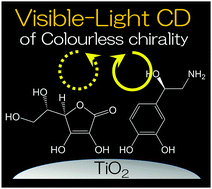Visible-light circular dichroism of colourless chiral organic compounds enabled by interfacial charge-transfer transitions†
Abstract
We report the visible-light circular dichroism (CD) of colourless organic compounds based on interfacial charge-transfer (ICT) transitions with TiO2 nanoparticles. We employed three kinds of colourless chiral compounds, L-ascorbic acid, D-ascorbic acid, and L-noradrenaline. These compounds showed a broad ICT band in the visible region between 400 and 600 nm upon their chemisorption on TiO2 nanoparticles. L-Ascorbic acid and L-noradrenaline adsorbed on the TiO2 nanoparticles showed positive and negative CD signals in the visible region, respectively. D-Ascorbic acid, which is the enantiomer of L-ascorbic acid, exhibited positive CD signals in the visible region, but different g factors (Δε/ε) from those of TiO2–L-ascorbic acid, well reflecting the different chirality of the substituent group. The visible-light CD based on ICT transitions enables selective visible-light CD sensing and imaging of colourless chiral biomolecules even if coexisting with other colourless chiral compounds such as proteins and DNA. Furthermore, the molecular dependence of the g factor allows us to identify chiral molecules.



 Please wait while we load your content...
Please wait while we load your content...